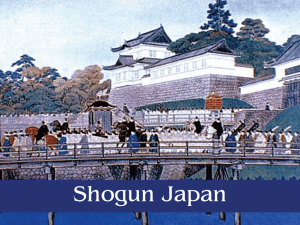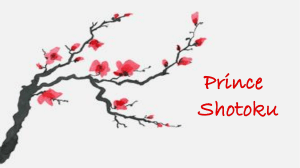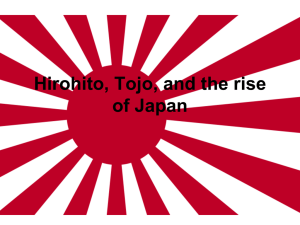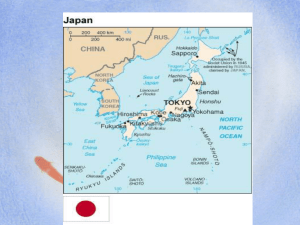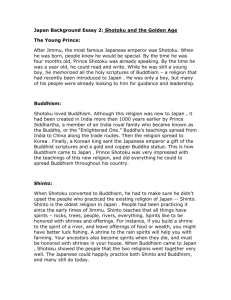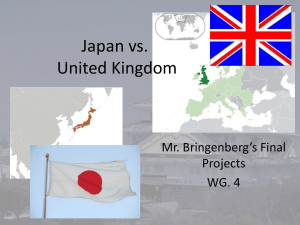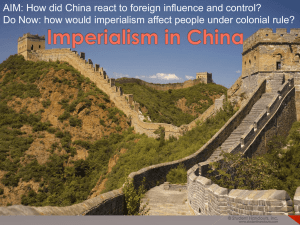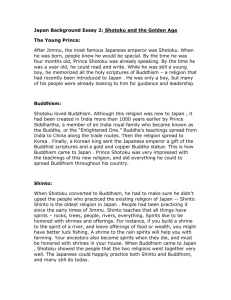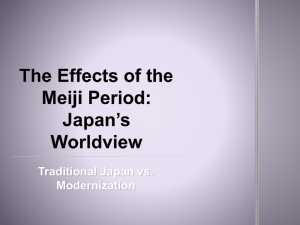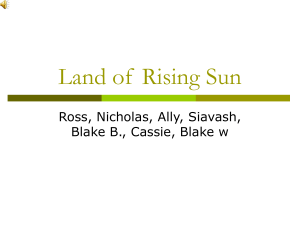14-1 PowerPoint
advertisement
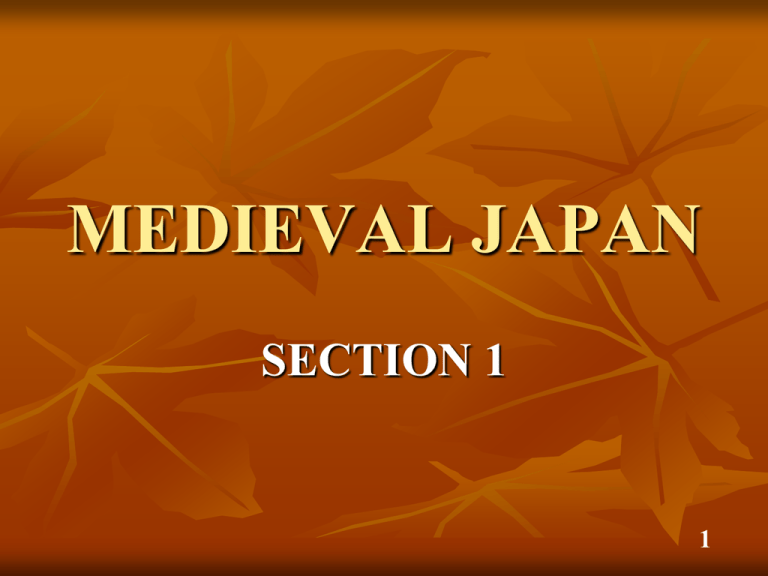
MEDIEVAL JAPAN SECTION 1 1 GEOGRAPHY OF JAPAN chain of islands in northern Pacific Ocean more than 3,000 islands most Japanese live on four largest islands mostly covered by mountains (80%) 20% farmable land 188 mountains are volcanoes many earthquakes occur lack of natural resources dependence on foreign territories geography isolates Japanese natural isolation (island nation) resulted in limited & selected foreign influence 2 Islands of Japan 3 Where did most Japanese live? Japan’s four largest islands Hokkaido located furthest north Honshu Largest Heian (Kyoto) Mt. Fuji Nara Edo (Tokyo – today capital of Japan) Shikoku smallest Kyushu located furthest south 4 5 MOUNT FUJI located on Honshu west of Tokyo highest mountain in Japan (12,388 ft.) symmetrical cone-shape sacred place- one of three holy mountains (Mt. Tate & Mt. Haku) believed to have a soul thousands climb yearly to reach shrine at top frequently depicted in art and photographs well-known symbol of Japan 6 MOUNT FUJI 7 JOMON means “cord marks” 5000 B.C. wandering groups made clay pottery, using knotted cords to make designs over time, settled in fishing villages along coast fishing way of life 8 9 YAYOI ancestors of the Japanese people introduced farming practiced skills learned from Chinese & Koreans potter’s wheel grew rice in paddies 10 POTTERY WHEEL 11 Rice Paddy 12 YAYOI (continued) skilled metal-workers spear axes, knives & hoes from iron swords, spears, & bells from bronze organized themselves into clans buried chiefs in tombs called kofun bell axe 13 CLANS group of families related by blood or marriage headed by small group of warriors warrior chiefs protected people for share of rice harvest under warriors – farmers, artisans, and servant of warriors 14 KOFUN large mounds of dirt carefully shaped and surrounded by ditches tombs where chiefs buried many large as big as Egypt’s pyramids largest longer than five football fields at least eight stories high filled with personal belongings pottery, tools, weapons, and armor 15 KOFUN MOUND 16 KOFUN BURIEL SITE 17 Myth: The Creation of Japan two gods dipped a spear into sea they pulled it out drops of salt water fell on water’s surface formed the islands of Japan two gods then created sun goddess Amaterasu 18 AMATERASU “sun goddess” ruled over Earth companion, Susanowo, storm god children became first people of Japan sent grandson, Ninigi, to rule over them Susanowo Ninigi gave him her mirror, her jewel, and a sword to make sure everyone accepts his power became sacred symbols of leadership 19 YAMATO clan in A.D. 500s brought most of Japan under its rule other clans held their lands gave loyalty to Yamato chief Yamato chiefs claimed they came from sun goddess result - had the right to rule 20 JIMMU Yamato leader took title “emperor of heaven” founded line of rulers never been broken Akihito is one of Jimmu’s descendants Japan’s emperor today 21 Prince Shotoku Prince Shotoku emerged as the leader of the Yamato clan & initiated a reform program modeled after Tang China. gave constitutional power to the emperor. 22 PRINCE SHOTOKU took charge of Japan on behalf of his Aunt, the empress Suiko (regent) powerful emperor with help of trained officials chosen for abilities wanted to create a strong government created Japan’s first constitution borrowed many ideas from China sent officials and students to China to study 23 CONSTITUTION a plan of government created by Prince Shotoku all power given to emperor even appointing officials created bureaucracy many ideas borrowed from China government divided into departments listed rules for working the government taken from ideas of Confucius 24 HORYUJI Shotoku ordered Buddhist temples and monasteries built throughout Japan Japan’s oldest temple world’s oldest surviving wooden building 25 TAIKA “great change” divided Japan into provinces or regional districts run by officials who reported to emperor all land under emperor’s control clan leaders… - can direct farmers working land - cannot collect taxes government officials gather part of farmer’s harvest in taxes for emperor 26 RESULTS Taika or “great change” PLUS Prince Shotoku’s reforms created Japan’s first strong centralized government 27 ANIMISM early Japanese belief all natural things are alive and have their own spirits the winds, mountains, and rivers people needing help, asked nature spirits to help them called nature spirits “kami” 28 KAMI “nature spirits” Kami helps Japanese only if a person is pure illness causes spiritual stains must be cleansed by bathing and other rituals before praying honor kami at shrines beliefs developed into Shinto religion 29 SHRINES Torii Gate holy place place of worship honored “kami” (nature spirits) priests, musicians, and dancers performed rituals people ask gods for…. a good harvest a wife a child some other favor Shinto Shrine 30 SHINTO Japanese religion means “way of the spirits” based on nature spirits believed all natural things were alive (the winds, mountains, and rivers) spiritual stains must be cleansed by bathing and other rituals before praying 31 32
